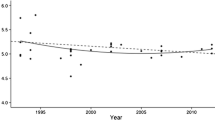Abstract
To develop and validate a sex-role inventory of traditional versus nontraditional behaviors for women, 574 single and 265 married females as well as 407 males completed the Robinson Behavioral Inventory (RBI). Thirty-four-item final versions of the two forms were established through criteria requiring items to be both reliable and reported at differential rates by male versus female or by traditional versus nontraditional women. High reliability of the total scale was evident by a measure of internal consistency as well as by a measure of equivalence. The validity of the total scale was established by demonstrating the RBI as positively correlated with an attitudinal measure of women's roles but as showing discriminant validity with a social desirability scale, a political orientation scale, and an assertiveness scale. Age, income, and educational level were used as covariates to partial out possible confounding effects. Future use of the RBI would suggest extending the sample to less well-educated and a greater variety of SES populations and to women who are not members of organizations. The value of the measure lies in the collection of specific behavioral data as distinct from broad attitudinal constructs allowing for determining the attitude-behavior relationship in the area of sex roles. As a tool for evaluating outcome studies measuring changes in sex roles, this inventory is unique.
Similar content being viewed by others
References
Baker, B. Acceptance versus rejection of the traditional feminine role: Considerations of women's liberation (Doctoral dissertation, Wayne State University, 1972). Dissertation Abstracts International, 1972, 33, 2157A-2158A.
Bem, S. The measurement of psychological androgyny. Journal of Consulting and Clinical Psychology, 1974, 42, 155–162.
Campbell, D., & Fiske, D. Convergent and discriminant validation by the multitrait-multimethod matrix. Psychological Bulletin, 1959, 56, 81–105.
Cherniss, C. Personality and ideology: A personalogical study of women's liberation. Psychiatry, 1972, 35, 109–125.
Comrey, A., & Newmeyer, J. Measurement of radicalism-conservatism. Journal of Social Psychology, 1965, 67, 357–369.
Cronbach, L. Essentials of psychological testing (2nd ed.). New York: Harper & Row, 1949.
Crowne, D., & Marlowe, D. The approval motive. New York: Wiley, 1964.
Dempewolff, J. Feminism and its correlates (Doctoral dissertation, University of Cincinnati, 1972). Dissertation Abstracts International, 1973, 33, 3913B-3914B.
Dempewolff, J. Development and validation of a feminism scale. Psychological Reports, 1974, 34, 651–657.
Edwards, A. Techniques of attitude scale construction. New York: Appleton-Century-Crofts, 1957.
Fishbein, M., & Ajzen, I. Belief, attitude, intention and behavior, Reading MA: Addison-Wesley, 1975.
Halas, C. Sex-role stereotypes: Perceived childhood socialization experiences and the attitudes and behavior of adult women. Journal of Psychology, 1974, 88, 261–275.
Joesting, J. Comparison of women's liberation members with their nonmember peers. Psychological Reports, 1971, 29, 1291–1294.
Kalin, R., & Tilby, P. J. Development and validation of a sex-role ideology scale. Psychological Reports, 1978, 42, 731–738.
Kilpatrick, D., & Smith, A. Validation of the Spence-Helmreich attitudes towards women scale. Psychological Reports, 1974, 35, 461–462.
Kirkpatrick, C. The construction of a belief pattern scale for measuring attitudes toward feminism. Journal of Social Psychology, 1936, 7, 421–437.
Kirsch, B. Consciousness-raising groups as therapy for women. In V. Franks & V. Burtle (Eds.), Women in therapy: New psychotherapies for a changing society. New York: Bruner/Mazel, 1974.
Mahoney, J. An analysis of the axiological structures of traditional and proliberation men and women. Journal of Psychology, 1975, 90, 31–39.
Mischel, W. Sex-typing and socialization. In P. Mussen (Ed.), Carmichael's manual of child psychology (Vol. 2). New York: Wiley, 1970.
Nunnally, J. Psychometric theory. New York: McGraw-Hill, 1967.
O'Keefe, B. Attitudes toward women's liberation: Relationship between cooperation, competition, personality and demographic variables (Doctoral dissertation, University of St. Louis, 1972). Dissertation Abstracts International, 1972, 33, 1293B.
Parelius, A. Emerging sex-role attitudes, expectations and strains among college women. Journal of Marriage and the Family, 1975, 37, 146–153.
Rathus, S. A 30-item schedule for assessing assertive behavior. Behavior Therapy, 1973, 4, 398–406.
Rowe, S., & Rowe, A. Complementary role relationships and level of income: A case for the American housewife. Psychology, 1973, 10, 1–3.
Rychman, R., Martins, J., Rodda, W., & Sheriman, M. Locus of control and attitudes towards women's liberation in a college population. Journal of Social Psychology, 1972, 87, 157–158.
Singleton, R., & Christiansen, J. B. The construct validation of a short form attitudes toward feminism scale. Sociology and Social Research, 1977, 61, 294–303.
Smith, E., Ferree, M., & Miller, F. A short scale of attitudes toward feminism. Representative Research in Social Psychology, 1975, 6, 51–56.
Spence, J. T., & Helmreich, R. The attitudes toward women scale: An objective instrument to measure attitudes toward the rights and roles of women in contemporary society. JSAS Catalogue of Selected Documents in Psychology, 1972, 2, 66. (Ms. No. 153).
Spence, J. T., Helmreich, R., & Stapp, J. A short version of the attitudes toward women scale (AWS). Bulletin of the Psychonomic Society, 1973, 2, 219–220.
Steinman, A. Cultural values, female role expectations and therapeutic goals: Research and interpretation. In V. Frank & V. Burtle (Eds.), Women in therapy: New psychotherapies for a changing society. New York: Bruner/Mazel, 1974.
Stoloff, C. Who joins women's liberation? Psychiatry, 1973, 36, 325–340.
Tavris, C. Woman and man. Psychology Today, 1972, 5, 57–64, 82–85. (a)
Tavris, C. The unlikely liberals: Attitudes toward the issues of women's liberation (Doctoral dissertation, University of Michigan, 1972). Dissertation Abstracts International, 1972, 32, 6542A. (b)
Whitely, R. Women in groups. The Counseling Psychologist, 1973, 4, 27–43.
Author information
Authors and Affiliations
Rights and permissions
About this article
Cite this article
Robinson, E.A., Follingstad, D.R. Development and validation of a behavioral sex-role inventory. Sex Roles 13, 691–713 (1985). https://doi.org/10.1007/BF00287304
Issue Date:
DOI: https://doi.org/10.1007/BF00287304




